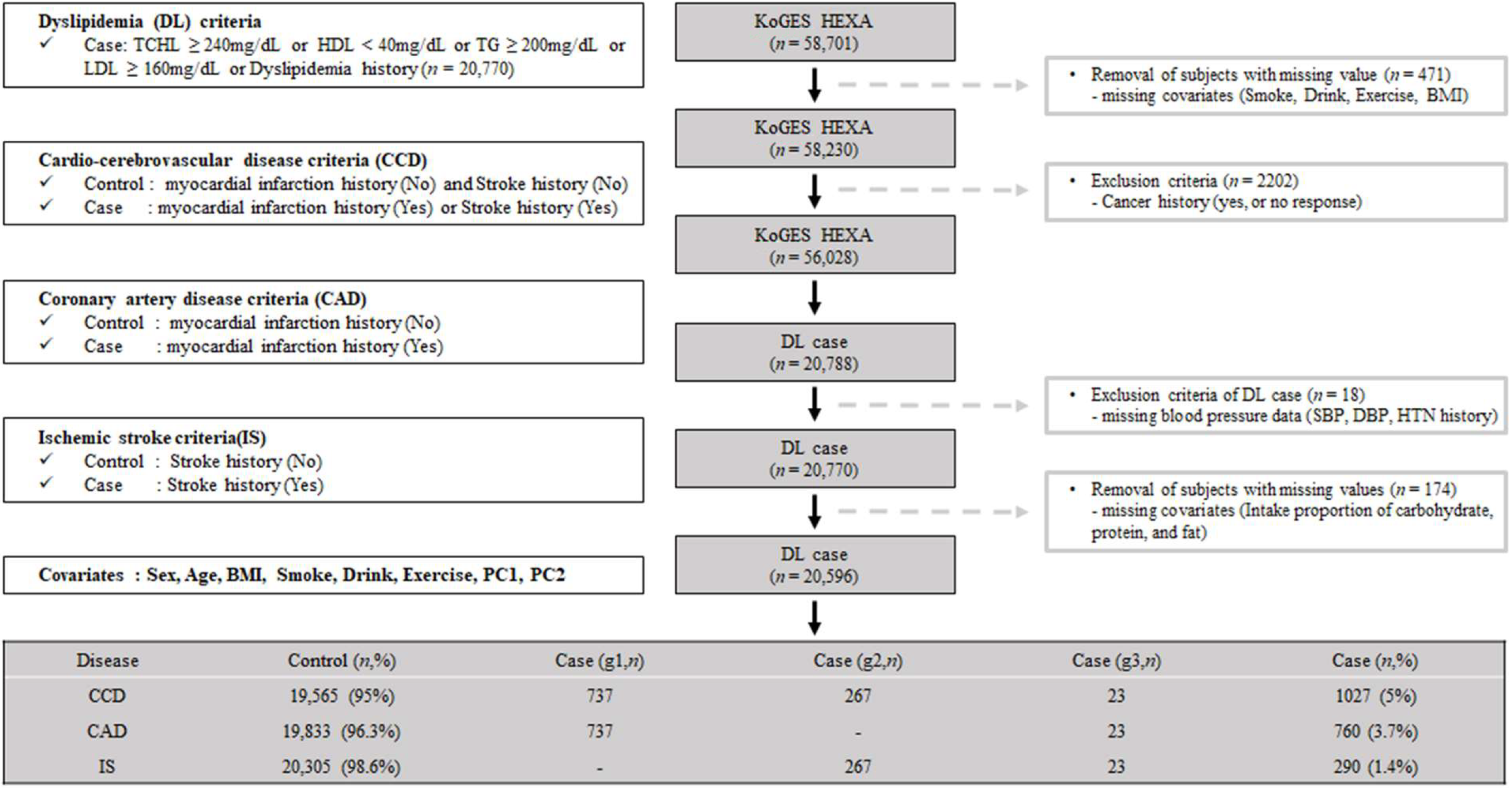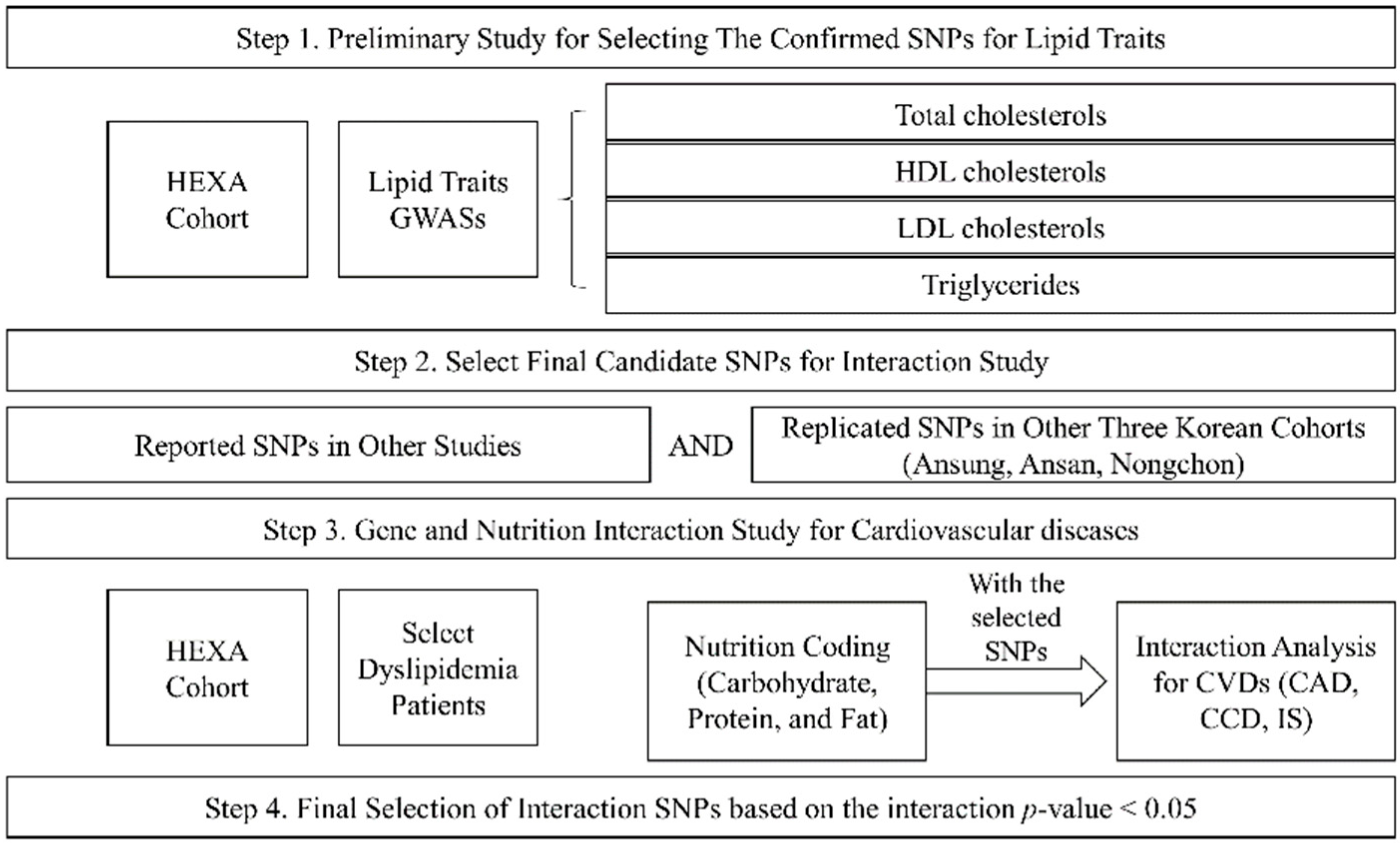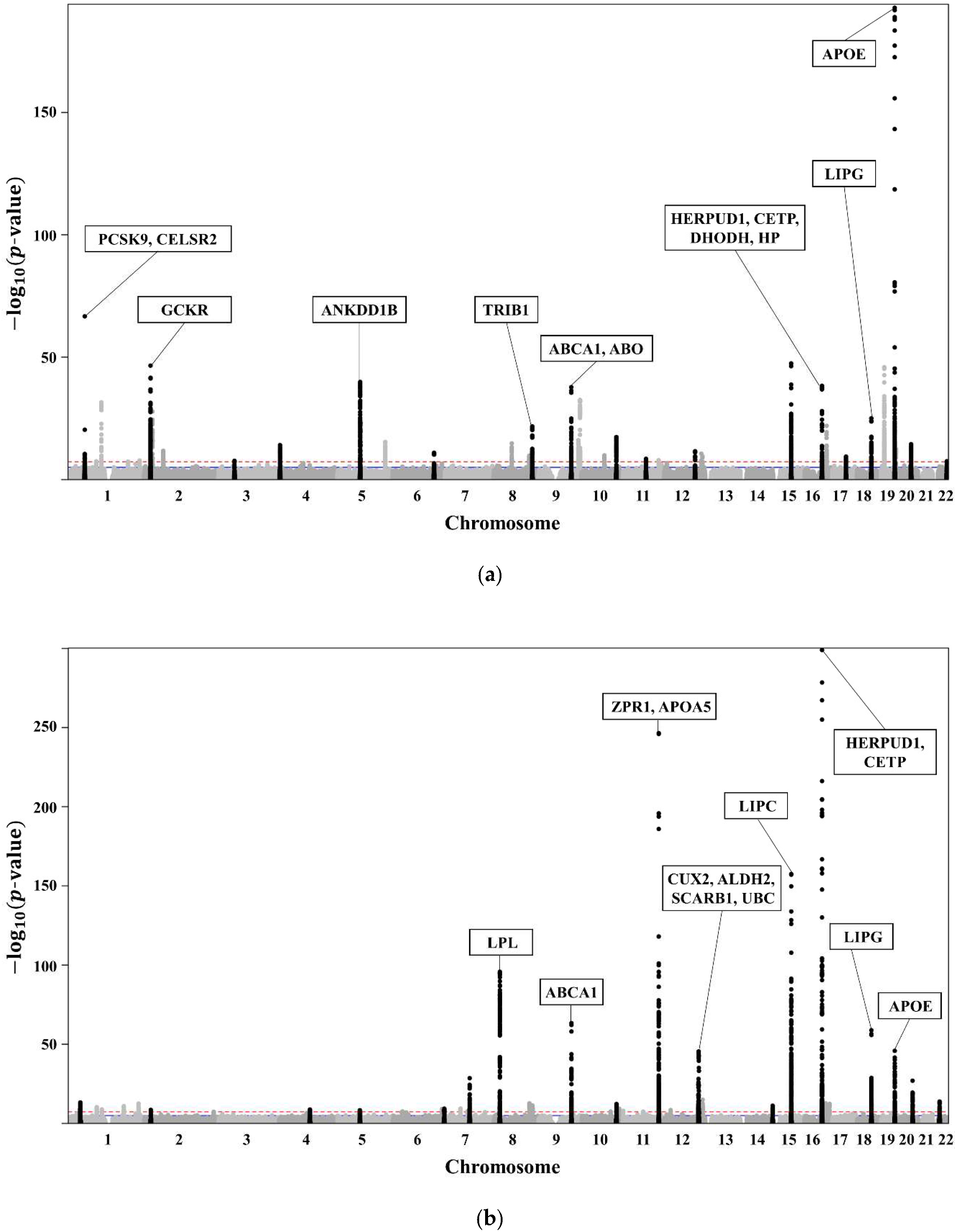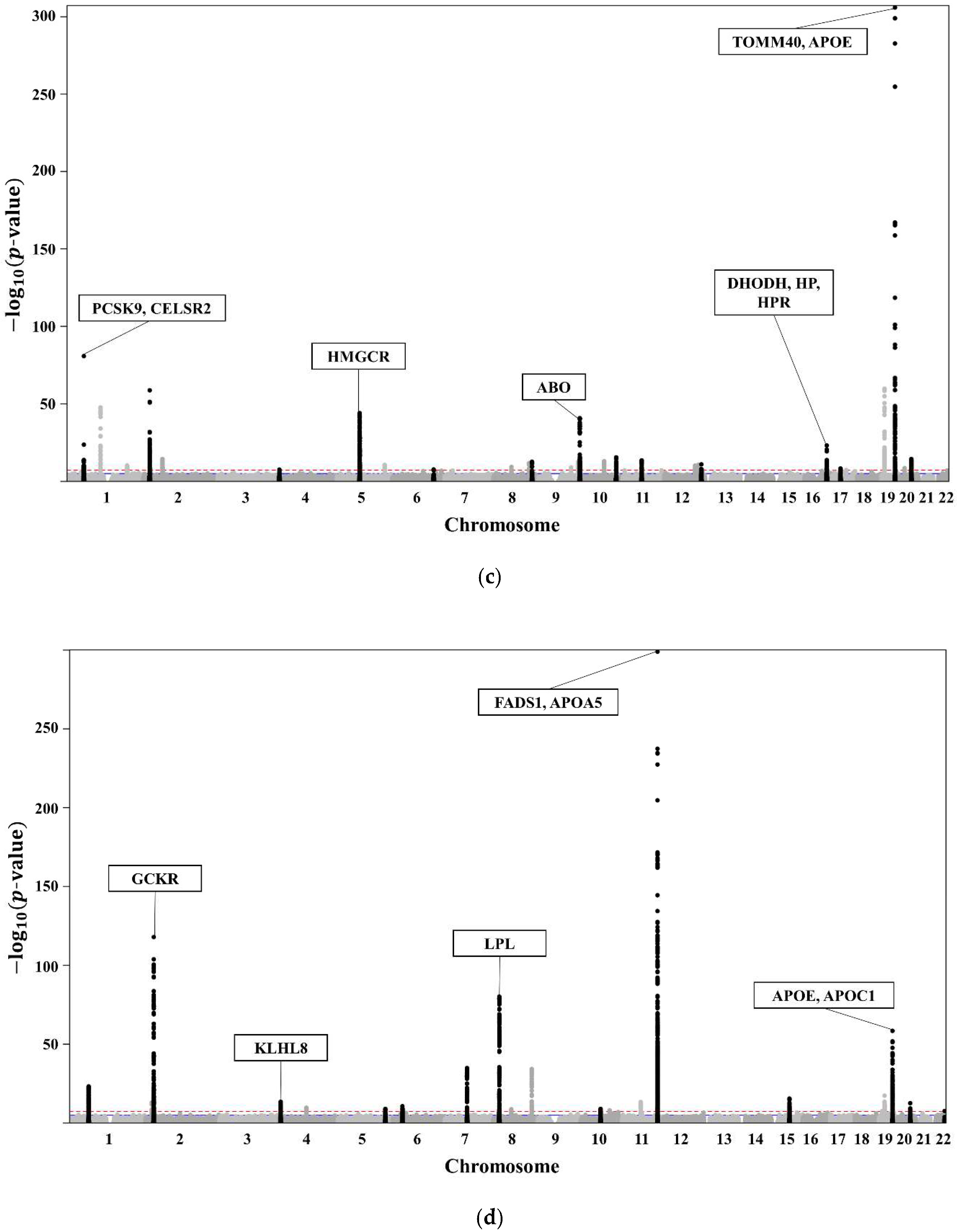Dyslipidaemia—Genotype Interactions with Nutrient Intake and Cerebro-Cardiovascular Disease
Abstract
1. Introduction
2. Materials and Methods
2.1. Study Population
2.2. Study Design
2.3. Measurement of Anthropometric and Biochemical Parameters
2.4. Definitions of Dyslipdemia and CVDs (CAD, IS, and CCD)
2.5. Definition of Nutrition Intake
2.6. Genotyping and Quality Control Procedures
2.7. Statistical Analysis
3. Results
4. Discussion
5. Conclusions
Supplementary Materials
Author Contributions
Funding
Institutional Review Board Statement
Informed Consent Statement
Data Availability Statement
Acknowledgments
Conflicts of Interest
References
- Nordestgaard, B.G.; Varbo, A. Triglycerides and cardiovascular disease. Lancet 2014, 384, 626–635. [Google Scholar] [CrossRef]
- Rhee, E.-J. Prevalence and current management of cardiovascular risk factors in korean adults based on fact sheets. Endocrinol. Metab. 2020, 35, 85–94. [Google Scholar] [CrossRef] [PubMed]
- Sun Huh, M. Cause-of-death statistics in the Republic of Korea. J. Korean Med. Assoc. 2016, 59, 221–232. [Google Scholar]
- Hedayatnia, M.; Asadi, Z.; Zare-Feyzabadi, R.; Yaghooti-Khorasani, M.; Ghazizadeh, H.; Ghaffarian-Zirak, R.; Nosrati-Tirkani, A.; Mohammadi-Bajgiran, M.; Rohban, M.; Sadabadi, F. Dyslipidemia and cardiovascular disease risk among the mashad study population. Lipids Health Dis. 2020, 19, 42. [Google Scholar] [CrossRef]
- Crowther, M.A. Pathogenesis of atherosclerosis. ASH Educ. Program Book 2005, 2005, 436–441. [Google Scholar] [CrossRef]
- Goff, D.C.; Lloyd-Jones, D.M.; Bennett, G.; Coady, S.; D’agostino, R.B.; Gibbons, R.; Greenland, P.; Lackland, D.T.; Levy, D.; O’donnell, C.J. 2013 ACC/AHA guideline on the assessment of cardiovascular risk: A report of the American College of Cardiology/American Heart Association task force on practice guidelines. J. Am. Coll. Cardiol. 2014, 63, 2935–2959. [Google Scholar] [CrossRef]
- Darroudi, S.; Saberi-Karimian, M.; Tayefi, M.; Arekhi, S.; Motamedzadeh Torghabeh, A.; Seyedzadeh Sani, S.M.R.; Moohebati, M.; Heidari-Bakavoli, A.; Ebrahimi, M.; Azarpajouh, M.R. Prevalence of combined and noncombined dyslipidemia in an Iranian population. J. Clin. Lab. Anal. 2018, 32, e22579. [Google Scholar] [CrossRef]
- Boren, J.; Chapman, M.J.; Krauss, R.M.; Packard, C.J.; Bentzon, J.F.; Binder, C.J.; Daemen, M.J.; Demer, L.L.; Hegele, R.A.; Nicholls, S.J. Low-density lipoproteins cause atherosclerotic cardiovascular disease: Pathophysiological, genetic, and therapeutic insights: A consensus statement from the European Atherosclerosis Society Consensus Panel. Eur. Heart J. 2020, 41, 2313–2330. [Google Scholar] [CrossRef]
- Miller, M. Dyslipidemia and cardiovascular risk: The importance of early prevention. Natl. Libr. Med. 2009, 102, 657–667. [Google Scholar] [CrossRef]
- Lloyd-Jones, D.M.; Nam, B.-H.; D’Agostino, R.B., Sr.; Levy, D.; Murabito, J.M.; Wang, T.J.; Wilson, P.W.; O’Donnell, C.J. Parental cardiovascular disease as a risk factor for cardiovascular disease in middle-aged adults: A prospective study of parents and offspring. JAMA 2004, 291, 2204–2211. [Google Scholar] [CrossRef]
- Rankinen, T.; Sarzynski, M.A.; Ghosh, S.; Bouchard, C. Are there genetic paths common to obesity, cardiovascular disease outcomes, and cardiovascular risk factors? Circ. Res. 2015, 116, 909–922. [Google Scholar] [CrossRef]
- McPherson, R.; Tybjaerg-Hansen, A. Genetics of coronary artery disease. Circ. Res. 2016, 118, 564–578. [Google Scholar] [CrossRef] [PubMed]
- Micha, R.; Peñalvo, J.L.; Cudhea, F.; Imamura, F.; Rehm, C.D.; Mozaffarian, D. Association between dietary factors and mortality from heart disease, stroke, and type 2 diabetes in the United States. JAMA 2017, 317, 912–924. [Google Scholar] [CrossRef] [PubMed]
- Fung, T.T.; Rexrode, K.M.; Mantzoros, C.S.; Manson, J.E.; Willett, W.C.; Hu, F.B. Mediterranean diet and incidence of and mortality from coronary heart disease and stroke in women. Circulation 2009, 119, 1093–1100. [Google Scholar] [CrossRef] [PubMed]
- Fung, T.T.; Chiuve, S.E.; McCullough, M.L.; Rexrode, K.M.; Logroscino, G.; Hu, F.B. Adherence to a dash-style diet and risk of coronary heart disease and stroke in women. Arch. Intern. Med. 2008, 168, 713–720. [Google Scholar] [CrossRef] [PubMed]
- Chiuve, S.E.; Fung, T.T.; Rimm, E.B.; Hu, F.B.; McCullough, M.L.; Wang, M.; Stampfer, M.J.; Willett, W.C. Alternative dietary indices both strongly predict risk of chronic disease. J. Nutr. 2012, 142, 1009–1018. [Google Scholar] [CrossRef]
- Kim, Y.; Han, B.-G.; Group, K. Cohort profile: The Korean Genome and Epidemiology Study (KoGES) consortium. Int. J. Epidemiol. 2017, 46, e20. [Google Scholar] [CrossRef]
- Song, Y.; Choi, J.-E.; Kwon, Y.-J.; Chang, H.-J.; Kim, J.O.; Park, D.-H.; Park, J.-M.; Kim, S.-J.; Lee, J.W.; Hong, K.-W. Identification of susceptibility loci for cardiovascular disease in adults with hypertension, diabetes, and dyslipidemia. J. Transl. Med. 2021, 19, 85. [Google Scholar] [CrossRef]
- Ahn, Y.; Kwon, E.; Shim, J.; Park, M.; Joo, Y.; Kimm, K.; Park, C.; Kim, D. Validation and reproducibility of food frequency questionnaire for Korean Genome Epidemiologic Study. Eur. J. Clin. Nutr. 2007, 61, 1435–1441. [Google Scholar] [CrossRef]
- Kwon, Y.-J.; Lee, H.S.; Park, J.-Y.; Lee, J.-W. Associating intake proportion of carbohydrate, fat, and protein with all-cause mortality in Korean adults. Nutrients 2020, 12, 3208. [Google Scholar] [CrossRef]
- Kwon, Y.-J.; Park, D.H.; Choi, J.-E.; Lee, D.; Hong, K.-W.; Lee, J.-W. Identification of the interactions between specific genetic polymorphisms and nutrient intake associated with general and abdominal obesity in middle-aged adults. Clin. Nutr. 2022, 41, 543–551. [Google Scholar] [CrossRef] [PubMed]
- Moon, S.; Kim, Y.J.; Han, S.; Hwang, M.Y.; Shin, D.M.; Park, M.Y.; Lu, Y.; Yoon, K.; Jang, H.-M.; Kim, Y.K. The Korea biobank array: Design and identification of coding variants associated with blood biochemical traits. Sci. Rep. 2019, 9, 1832. [Google Scholar] [CrossRef] [PubMed]
- Pruim, R.J.; Welch, R.P.; Sanna, S.; Teslovich, T.M.; Chines, P.S.; Gliedt, T.P.; Boehnke, M.; Abecasis, G.R.; Willer, C.J. LocusZoom: Regional visualization of genome-wide association scan results. Bioinformatics 2010, 26, 2336–2337. [Google Scholar] [CrossRef] [PubMed]
- Chang, C.C.; Chow, C.C.; Tellier, L.C.; Vattikuti, S.; Purcell, S.M.; Lee, J.J. Second-generation plink: Rising to the challenge of larger and richer datasets. Gigascience 2015, 4, s13742–015–0047–8. [Google Scholar] [CrossRef]
- Annema, W.; Tietge, U.J. Role of hepatic lipase and endothelial lipase in high-density lipoprotein—Mediated reverse cholesterol transport. Curr. Atheroscler. Rep. 2011, 13, 257–265. [Google Scholar] [CrossRef]
- Thuren, T. Hepatic lipase and HDL metabolism. Curr. Opin. Lipidol. 2000, 11, 277–283. [Google Scholar] [CrossRef]
- Cohen, J.C.; Vega, G.L.; Grundy, S.M. Hepatic lipase: New insights from genetic and metabolic studies. Curr. Opin. Lipidol. 1999, 10, 259–267. [Google Scholar] [CrossRef]
- Carr, M.C.; Brunzell, J.D.; Deeb, S.S. Ethnic differences in hepatic lipase and HDL in Japanese, black, and white Americans: Role of central obesity and LIPC polymorphisms. J. Lipid Res. 2004, 45, 466–473. [Google Scholar] [CrossRef]
- Griffin, J.H.; Kojima, K.; Banka, C.L.; Curtiss, L.K.; Fernández, J.A. High-density lipoprotein enhancement of anticoagulant activities of plasma protein S and activated protein C. J. Clin. Investig. 1999, 103, 219–227. [Google Scholar] [CrossRef]
- Dahlbäck, B. The protein C anticoagulant system: Inherited defects as basis for venous thrombosis. Thromb. Res. 1995, 77, 1–43. [Google Scholar] [CrossRef]
- Marlar, R.A.; Kleiss, A.J.; Griffin, J.H. Mechanism of action of human activated protein C, a thrombin-dependent anticoagulant enzyme. Blood 1982, 59, 1067–1072. [Google Scholar] [CrossRef] [PubMed]
- Oslakovic, C.; Norstrøm, E.; Dahlbäck, B. Reevaluation of the role of HDL in the anticoagulant activated protein C system in humans. J. Clin. Investig. 2010, 120, 1396–1399. [Google Scholar] [CrossRef] [PubMed]
- Gordon, D.J.; Probstfield, J.L.; Garrison, R.J.; Neaton, J.D.; Castelli, W.P.; Knoke, J.D.; Jacobs, D.R., Jr.; Bangdiwala, S.; Tyroler, H.A. High-density lipoprotein cholesterol and cardiovascular disease. Four prospective American studies. Circulation 1989, 79, 8–15. [Google Scholar] [CrossRef] [PubMed]
- Tall, A.R. Plasma high density lipoproteins. Metabolism and relationship to atherogenesis. J. Clin. Investig. 1990, 86, 379–384. [Google Scholar] [CrossRef]
- Khan, M.N.; Khan, H.; Ahmad, M.; Umar, M. Serum total and HDL-cholesterol in ischemic and hemorrhagic stroke. Ann. Pak. Inst. Med. Sci. 2014, 10, 22–26. [Google Scholar]
- Kelly, R.B. Diet and exercise in the management of hyperlipidemia. Am. Fam. Physician 2010, 81, 1097–1102. [Google Scholar]
- Willett, W.C.; Sacks, F.; Trichopoulou, A.; Drescher, G.; Ferro-Luzzi, A.; Helsing, E.; Trichopoulos, D. Mediterranean diet pyramid: A cultural model for healthy eating. Am. J. Clin. Nutr. 1995, 61, 1402S–1406S. [Google Scholar] [CrossRef]
- Rondanelli, M.; Giacosa, A.; Morazzoni, P.; Guido, D.; Grassi, M.; Morandi, G.; Bologna, C.; Riva, A.; Allegrini, P.; Perna, S. Mediterrasian diet products that could raise HDL-cholesterol: A systematic review. BioMed Res. Int. 2016, 2016, 15. [Google Scholar] [CrossRef]
- Mozaffarian, D. Dietary and policy priorities for cardiovascular disease, diabetes, and obesity: A comprehensive review. Circulation 2016, 133, 187–225. [Google Scholar] [CrossRef]
- Schaefer, A.S.; Richter, G.M.; Groessner-Schreiber, B.; Noack, B.; Nothnagel, M.; Mokhtari, N.-E.E.; Loos, B.G.; Jepsen, S.; Schreiber, S. Identification of a shared genetic susceptibility locus for coronary heart disease and periodontitis. PLoS Genet. 2009, 5, e1000378. [Google Scholar] [CrossRef]
- Beaney, K.E.; Ward, C.E.; Bappa, D.A.; McGale, N.; Davies, A.K.; Hirani, S.P.; Li, K.; Howard, P.; Vance, D.R.; Crockard, M.A. A 19-SNP coronary heart disease gene score profile in subjects with type 2 diabetes: The coronary heart disease risk in type 2 diabetes (CoRDia study) study baseline characteristics. Cardiovasc. Diabetol. 2016, 15, 141. [Google Scholar] [CrossRef] [PubMed]
- Adams, J.N.; Raffield, L.M.; Freedman, B.I.; Langefeld, C.D.; Ng, M.C.; Carr, J.J.; Cox, A.J.; Bowden, D.W. Analysis of common and coding variants with cardiovascular disease in the Diabetes Heart Study. Cardiovasc. Diabetol. 2014, 13, 77. [Google Scholar] [CrossRef] [PubMed]




| Characteristics | City Cohort (KoGES HEXA) |
|---|---|
| Number of subjects | 58,610 |
| Age, years | 53.8 ± 8.0 |
| Female, n (%) | 38,330 (65.4) |
| Anthropometric traits | |
| BMI, kg/m2 | 23.89 ± 2.88 |
| Biochemical traits | |
| Total cholesterol, mg/dL | 197.15 ± 35.31 |
| HDL cholesterol, mg/dL | 53.66 ± 12.95 |
| LDL cholesterol, mg/dL | 117.29 ± 35.19 |
| Triglycerides, mg/dL | 120.90 ± 69.01 |
| Lifestyle factors | |
| Smoking status: Never/Quit/ Current, n (%) | 42,765 (73.0)/9243 (15.8)/6408 (10.9) |
| Drinking status: Never/Quit/ Current, n (%) | 30,273 (51.7)/2204 (3.8)/25,895 (44.2) |
| Exercise status: No/Yes, n (%) | 26,488 (45.2)/31,922 (54.5) |
| CAD, n (%) | 1669 (2.9) |
| IS, n (%) | 708 (1.2) |
| CCD, n (%) | 2326 (4.0) |
| Total energy, kcal/day | 1744.15 ± 551.17 |
| Carbohydrates (%) | 71.72 ± 6.98 |
| Protein (%) | 13.41 ± 2.57 |
| Fat (%) | 13.87 ± 5.40 |
| Characteristics | Dyslipidaemia Group |
|---|---|
| Number of subjects | 20,596 |
| Age, years | 55.3 ± 7.6 |
| Female, n (%) | 12,014 (58.3) |
| Treatments | |
| Drugs, n (%) | 2293 (11.13) |
| Diet, n (%) | 21 (0.1) |
| Fitness, n (%) | 30 (0.15) |
| Drugs and Diet, n (%) | 32 (0.16) |
| Drugs and Fitness, n (%) | 148 (0.72) |
| Diet and Fitness, n (%) | 64 (0.31) |
| Drugs, Diet and Fitness, n (%) | 206 (1.00) |
| Anthropometric traits | |
| BMI, kg/m2 | 24.67 ± 2.82 |
| Biochemical traits | |
| Total cholesterol, mg/dL | 212.21 ± 43.91 |
| HDL cholesterol, mg/dL | 48.43 ± 13.78 |
| LDL cholesterol, mg/dL | 128.51 ± 42.29 |
| Triglycerides, mg/dL | 176.37 ± 114.19 |
| Lifestyle factors | |
| Smoking status: Never/Quit/ Current, n (%) | 13,760 (66.8)/3828 (18.6)/3008 (14.6) |
| Drinking status: Never/Quit/ Current, n (%) | 10,501 (51)/882 (4.3)/9213 (44.7) |
| Exercise status: No/Yes, n (%) | 9950 (48.3)/10,646 (51.7) |
| CAD, n (%) | 760 (3.7) |
| IS, n (%) | 290 (1.4) |
| CCD, n (%) | 1027 (5) |
| Total energy, kcal/day | 1745.32 ± 548.61 |
| Carbohydrates (%) | 72.01 ± 6.96 |
| Protein (%) | 13.35 ± 2.58 |
| Fat (%) | 13.59 ± 5.38 |
Publisher’s Note: MDPI stays neutral with regard to jurisdictional claims in published maps and institutional affiliations. |
© 2022 by the authors. Licensee MDPI, Basel, Switzerland. This article is an open access article distributed under the terms and conditions of the Creative Commons Attribution (CC BY) license (https://creativecommons.org/licenses/by/4.0/).
Share and Cite
Lee, S.-B.; Choi, J.-E.; Park, B.; Cha, M.-Y.; Hong, K.-W.; Jung, D.-H. Dyslipidaemia—Genotype Interactions with Nutrient Intake and Cerebro-Cardiovascular Disease. Biomedicines 2022, 10, 1615. https://doi.org/10.3390/biomedicines10071615
Lee S-B, Choi J-E, Park B, Cha M-Y, Hong K-W, Jung D-H. Dyslipidaemia—Genotype Interactions with Nutrient Intake and Cerebro-Cardiovascular Disease. Biomedicines. 2022; 10(7):1615. https://doi.org/10.3390/biomedicines10071615
Chicago/Turabian StyleLee, Sung-Bum, Ja-Eun Choi, Byoungjin Park, Mi-Yeon Cha, Kyung-Won Hong, and Dong-Hyuk Jung. 2022. "Dyslipidaemia—Genotype Interactions with Nutrient Intake and Cerebro-Cardiovascular Disease" Biomedicines 10, no. 7: 1615. https://doi.org/10.3390/biomedicines10071615
APA StyleLee, S.-B., Choi, J.-E., Park, B., Cha, M.-Y., Hong, K.-W., & Jung, D.-H. (2022). Dyslipidaemia—Genotype Interactions with Nutrient Intake and Cerebro-Cardiovascular Disease. Biomedicines, 10(7), 1615. https://doi.org/10.3390/biomedicines10071615







